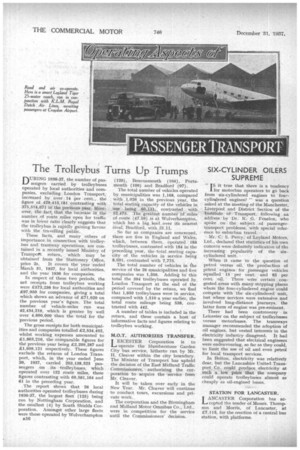The Trolleybus Turns Up Trumps
Page 28

If you've noticed an error in this article please click here to report it so we can fix it.
nURING 1936-37, the number of pas sengers carried by trolleybuses operated by local authorities and companies, excluding London Transport, increased by Over 14 per : cent., the figure of 429,415,181 contrasting with 375,514,671'in-the previous year Moreover the. fact. that the increase iii. the number. of route miles open for traffic was in loWer ratio Clearly suggests that the trolleybus is rapidly gaining favour
with the travelling public. • These facts, and many others of importance in connection with trolleybus and tramway operations, are contained in a recently issued Ministry of Transpott return, which may . be obtained from the Stationery Office, price 2s. It covers the year 'ended March 31, 1937, for local .authorities, and the year 1936 for companies.
In respect of these two periods, the net receipts from trolleybus working were £573,236 for local authorities and £97,950 for companies, giving a total which shows an advance of £71,020 on the previous year's figure. The total number of vehicle-miles run was 42,434,219, which is greater by well over 4,600,000 than the total for the previous period.
The gross receipts for both municipalities and companies totalled £2,534,402, whilst working expenses amounted to £1,863,216, the comparable figures for the previous year being £2,209,287 and 41,609,121 respectively. These figures exclude the returns of London Transport, which, in the year ended June 30, 1937, carried 203,138,323 passengers on its trolleybuses, which operated over 122 route miles, these figures contrasting with 69,581,164 and 61 in the preceding year.
The report shows that 26 local authorities operated trolleybuses during 1936-37. the largest fleet (125) being run by Nottingham Corporation, and the smallest (4) by South Shields Corporation. Amongst other large fleets were those operated by Wolverhampton (120), Bonrnemouth (104), Portsmouth (100) and Bradford (97).
The total number of vehicles operated by municipalities was 1,168, compared with .1,026 in the previous year, the total seating capacity of the vehicles in use being 60,131. contrasted with 52,473. The greatest number 'of miles of route (47.59) • is at Wolverhampton, which has a big. lead, over its nearest rival. Bradford, with 81.11.
• So far as companies are concerned, there are five in England and Wales; which, between them, operated 188 trolleybuses, contrasted with 184 in the preceding year, thetotal seating capacity of the vehicles in service being
8,031, contrasted with 7,775. , The total number of vehicles in the service of the 26 municipalities and five companies was 1,356. Adding to this total the 594 trolleybuses operated by London Transport at the end of the period covered by the return, we find that 1,950 trolleybuses were in service; compared with 1,510 a year earlier, the total route mileage being 538, contrasted with 442.
A number of tables is included in the return, and these contain a host of informative facts and figures relating to trolleybus working.
M.O.T. AUTHORIZES TRANSFER.
EICESTER Corporation is to operate the liumberstone Garden City bus service, hitherto run by Mr. H. Cleaver within the city boundary. The Minister of Transport has upheld the decision of the East Midland Traffic Commissioners, authorizing the corporation to acquire the service from. Mr. Cleaver.
It will be taken over early in the New Year. Mr. Cleaver will continue to conduct tours, excursions and private work.
The corporation and the Birmingham and Midland Motor Omnibus Co., Ltd., were in competition for the service until the Commissioners' decision.
































